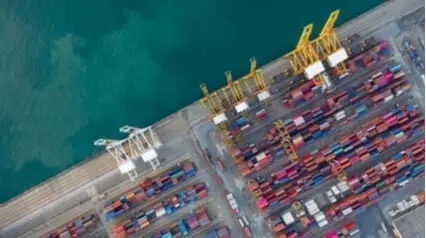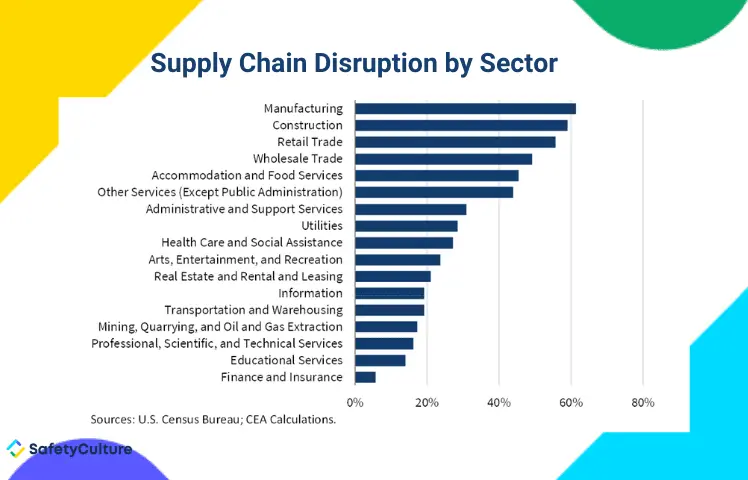What is Supply Chain Disruption?
Supply chain disruption is an interruption in the flow or production, sales, and distribution of specific goods or services. A systematized supply chain is crucial for maintaining the quality of products from start to finish and ensuring that all resources used are of the best quality.

Supply Chain Disruption
Bottlenecks or any congestion in the production system often result in delays and higher production costs. Supply chain disruption is also one of the many challenges brought about by the Covid-19 pandemic.
China’s strict “zero-Covid policy,” introduced early in the pandemic and aims to control the spread of the virus by strict travel restrictions and lockdowns, impacted international supply chains but was a win for China’s economy as the country was eventually able to ease local restrictions and became the only major economy to grow in 2020.
The new and highly-transmissible Omicron variant might change that though.
According to this recently published article from CNBC, economists say that the policy could pose another threat to the global supply chains and may further weigh on consumer consumption and economic growth because, whereas other countries are learning to adapt and make their supply chains more resilient to disruptions, China is still counting on the ‘zero-tolerance’ policy.
This in turn can impact the supplies around the world as a great number of manufacturers are situated in China.
Cause, Effect, and Level of Severity
Just like any other factors in the socio-economic industry, supply chain disruption has various causes and effects that may impact the economy and the process of turning raw materials to final goods.
Causes of Supply Chain Disruption
The origin of supply chain disruption in different industries can be caused by internal or external factors. Below are the usual aspects that might cause these disruptions and that companies and organizations should be aware of:
- Cyber and security attacks – this includes ransomware or data leak attacks;
- Financial and company viability – any internal or company-related concern that may hinder the production including revenue outlook;
- Transportation or logistics – includes issues in weather, traffic, shipping damages, or delays;
- Man-made – this includes human errors, fire, warehouse explosion;
- Geopolitical instability – disruption caused by any global political events. An example of this is tensions between economic powerhouses; and
- Natural disasters – catastrophic damages that can significantly affect the supply chain like earthquakes, wildfires, and extreme weather.
Effects of Supply Chain Disruption
Global cost of disruptions such as those brought about by the pandemic have been enormous. These disruptions greatly impact the whole chain and cause several repercussions that will most likely materialize eventually. Below are the known effects of supply chain disruptions:
- Shortages – or scarcity in specific products because of material insufficiency;
- Inflation – the rise in demand can cause price increases;
- Factory/store closures – decrease in production or output can result to business closures;
- Unemployment – like a domino effect, all these factors can result to increase in unemployment; and
- Threat to national security – this is broadly defined as the nation’s ability to protect the well-being of its citizens and this is one of the hidden impacts of the supply chain disruption.
The impact of disruptions in various industries substantially affects the global supply chain and the global economy. A survey of 200 supply chain executives done by Ernest & Young LLP in the United States, shows that 72 percent of the companies reported that these disruptions adversely affected their operations and that only 2 percent responded that they were prepared for the challenges.
Levels of Supply Chain Disruption Severity
Supply chain disruptions can come in many forms but can mostly be categorized into two factors; probability of occurrence—which refers to the likelihood of it happening; and severity—which can be classified in three levels, they are as follows:
- Low – these are disruptions that have short-term effects and can often be resolved once the specific issue worked out. Examples of these are logistical problems or delays caused by transportation.
- Medium – this can best be described as any disruptive event that can impact the production from weeks to months. An example of this is any incident in the production floor that halted work so much and caused losses that it needs to be included in the organization’s quarterly financial report.
- High – high severity disruptions will have a significant impact and long-term effects on time, money, and the supply chain in general. One perfect example of this is the ongoing pandemic and its economic impact in multiple industries.
Supply Chain Disruption Examples
The unprecedented Covid-19 pandemic affected innumerable industries and disrupted major supply chains globally. Known for its significant economic effects, different industry disruptions were experienced worldwide.
People started working from home and this created a higher demand for electronic gadgets, therefore shifting the demand for semiconductors to consumer electronics which heavily affected the Automotive Industry. This shortage also recognized the opportunity for expanding chip supply chains, and production need not only heavily rely on a few manufacturing sites that produce the majority of the world’s semiconductors.
In relation to the above mentioned industry, the Electronics Industry is also experiencing a supply chain disruption for various reasons1) there was an increase in demand for semiconductors for the automotive industry; 2) covid-related manufacturing disruptions; 3) logistics/transportation concerns for the supply; and 4) increased demand for electronic gadgets itself.
The infamous 2021 Suez Canal obstruction by Ever Given cargo ship is an example of a possible human error in cargo consolidation and disruption. The cargo ship blocked Egypt’s canal for almost 7 days and disrupted global trade, which cost almost $10 billion in losses per day. In response to this, an expansion project for the canal is expected to be completed by July of 2023, according to the Suez Canal Authority.
The Retail Industry was also considerably affected by the pandemic. Just in 2020, a record number of 12,000 stores closed in the United States as consumers turned to e-commerce and avoided brick-and-mortar stores.
One other example of a supply chain disruption cause is Brexit. This geopolitical move created implications on how manufacturers source, transport, assemble, price their products, and make them consumer-available.
How to Proactively Respond or Manage Supply Chain Disruption
The effects brought about by the pandemic in the economy, various industries, government bodies, and societies are continually materializing — so it won’t be far-fetched to say that they are here to stay.
In order to keep up with evolving situations, companies need to make their supply chains more resilient and strategic. Listed below are some aspects enterprises could consider in addressing disruption:
- Be aware of supply chain disruptions risks and their possible consequences to production. This can help in proactively identifying issues and efficiently fixing them. A great way to do this is by using a predictive analytics tool.
- Diversifying supply chains and assessing sourcing strategies – companies should have secondary to tertiary backup plans for material resources to mitigate disruption in case the primary supplier is compromised.
- Reallocating capital if needed – the sudden lockdowns at the start of the pandemic reinforced the need for the capability to have employees work from home, this created a shift in capital allocation of businesses and would most likely continue post-pandemic.
- Following a Good Distribution Practice will protect distributors from situations that would not only damage their reputation in the industry but might also harm the consumers and may potentially lead to a huge loss in customers.
- Enterprises essentially should have an efficient Business Continuity Plan in place that would enable continuous production despite business disruptions.
- Implement Supply Chain Transparency by using big data, intelligent systems, and connected ecosystems. The benefits of doing this are 1) this will easily communicate shortages/issues at any point in the supply chain so it’s easily adjustable; 2) ensure consumer satisfaction and brand loyalty by guaranteeing the products and where they came from; and 3) improve industry practices that isn’t limited to the specific business but can be beneficial to the industry as a whole.
Create Your Own Supplier Audit Checklist
Eliminate manual tasks and streamline your operations.
Get started for FREEMobile App to Avoid Disruption in the Supply Chain
SafetyCulture (formerly iAuditor) is a powerful inspection platform used by industry leaders to monitor the status of every part of the supply chain process. Use SafetyCulture checklists starting from suppliers/vendors, producers, warehouses, distributors, to retailers in order to avoid disruptions in production and to guarantee the quality of products and services.
- Use SafetyCulture checklists for every link of the supply chain and ensure a smoother flow of the whole process from start to end.
- SafetyCulture’s Analytics can be used by Small and Medium-size Enterprises (SMEs) to easily spot at what point in the supply chain they consistently encounter issues and address these accordingly.
- Businesses need to quickly adapt to the ever-changing and uncertain landscape of the economy and evolving consumer demand. Using digital tools like SafetyCulture offers good resiliency that can benefit the supply chain process in the long run.
- Great contingency plan for the situation where workers aren’t always physically present. Communicate effectively with people, anytime and anywhere.
- Easily accessible, no programming or coding needed, and anyone who uses a mobile device can use SafetyCulture.
- Train workers and relevant stakeholders in the supply chain to ensure compliance with quality standards and standardize maintenance of assets such as production equipment, machinery, and the like.





